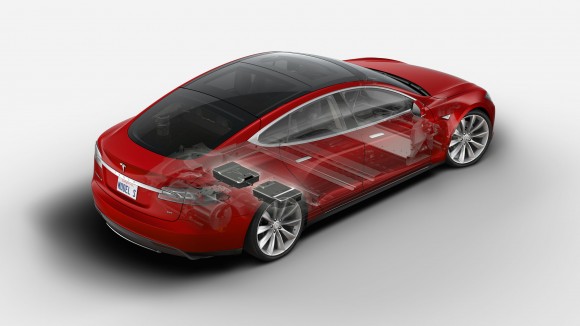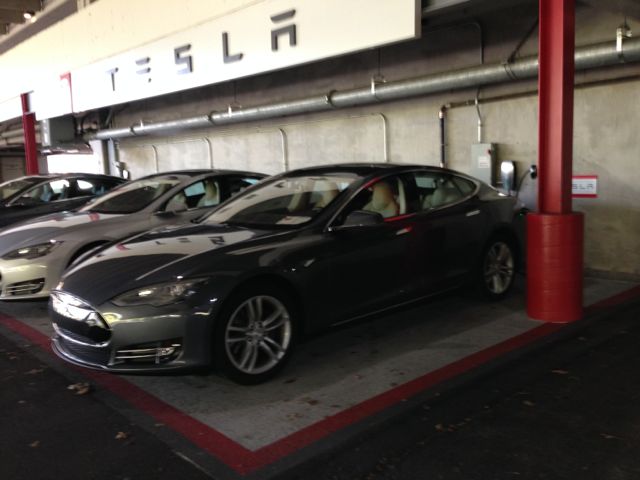News
Tesla Service Centers to Install Twin-Charging Option

Tesla’s destination charging initiative is moving fast in 2015, with expansion in North America, China and Hong Kong, along with expansion efforts in Europe coming in the 2nd quarter according to a Tesla shareholder letter. With many developments happening Tesla service centers will now install dual-chargers to Model S cars—needed for optimum destination charging—and remove this installation overhead from the Fremont plant.
Tesla Motors Club commenters noticed this change in early March when Tesla removed the twin charger option ($1,500) from the online Design Studio build out process that enables purchasing of the vehicle directly though the company’s web site. Tesla service centers will now retrofit Model S’ with the onboard twin-charger for a total cost of $2,000, a decrease from the previous $3,500 charge prior to March of this year.
The move screams factory efficiency and larger production volume needed for the Fremont plant as the company attempts to deliver 50,000 Model S vehicles in 2015—this does bolster Elon’s supply constrained argument.
This is classic Musk finding revenue in the short- and long-term (think Model 3), as more Model S owners may move towards a dual-charging retrofit. It’s a very attractive option for owners that look to plan an all electric road trip.
With Tesla HPWC chargers available (capable of charging at 80 amps and 59 miles/hr.,) at your hotel or accommodation, an owner has much greater flexibility in “hitting the town” without having to worry about an over night charge. For example, drive around Boston for the day and come back to the hotel before dinner. A quick rest at the hotel, with the Model S plugged into the destination charger, could potentially yield over 100 miles of range before one heads back out for dinner.
It really affirms Musk’s goal of creating the total car, first and foremost, that does everything a regular gas car can do. No limits.
As a recent road trip planner, the ability to charge quickly is a prerequisite for a family vacation. Tesla will have more “competition” with the expansion of the CHAdeMO DC-fast charging infrastructure on the east and west coast. Maryland and Pennsylvania are adding DC charging stations at turnpike stations in the keystone state and the surrounding Baltimore and Washington D.C. area.
Tesla has started to deliver Tesla’s CHAdeMO adapter to customers which costs $450 on top of the $2,000 twin-charging option. The cost alone may provide some deliberation for owners. Keep in mind that one should expect to pay for fast-charging access once outside of Tesla’s Supercharger and destination charging network.
We’ve heard of some buyer’s remorse from Tesla owners who plunked down the $2,000+ for the additional options only to realize that they don’t use the twin-chargers much. They may change their tune if they happened to be charging cost free at a fine resort in the Sierras
So what are owners thinking when it comes to the retrofit cost? Leave your comments below or engage with us @Teslarati!

Elon Musk
SpaceX issues statement on Starship V3 Booster 18 anomaly
The incident unfolded during gas-system pressure testing at the company’s Massey facility in Starbase, Texas.

SpaceX has issued an initial statement about Starship Booster 18’s anomaly early Friday. The incident unfolded during gas-system pressure testing at the company’s Massey facility in Starbase, Texas.
SpaceX’s initial comment
As per SpaceX in a post on its official account on social media platform X, Booster 18 was undergoing gas system pressure tests when the anomaly happened. Despite the nature of the incident, the company emphasized that no propellant was loaded, no engines were installed, and personnel were kept at a safe distance from the booster, resulting in zero injuries.
“Booster 18 suffered an anomaly during gas system pressure testing that we were conducting in advance of structural proof testing. No propellant was on the vehicle, and engines were not yet installed. The teams need time to investigate before we are confident of the cause. No one was injured as we maintain a safe distance for personnel during this type of testing. The site remains clear and we are working plans to safely reenter the site,” SpaceX wrote in its post on X.
Incident and aftermath
Livestream footage from LabPadre showed Booster 18’s lower half crumpling around the liquid oxygen tank area at approximately 4:04 a.m. CT. Subsequent images posted by on-site observers revealed extensive deformation across the booster’s lower structure. Needless to say, spaceflight observers have noted that Booster 18 would likely be a complete loss due to its anomaly.
Booster 18 had rolled out only a day earlier and was one of the first vehicles in the Starship V3 program. The V3 series incorporates structural reinforcements and reliability upgrades intended to prepare Starship for rapid-reuse testing and eventual tower-catch operations. Elon Musk has been optimistic about Starship V3, previously noting on X that the spacecraft might be able to complete initial missions to Mars.
Investor's Corner
Tesla analyst maintains $500 PT, says FSD drives better than humans now
The team also met with Tesla leaders for more than an hour to discuss autonomy, chip development, and upcoming deployment plans.

Tesla (NASDAQ:TSLA) received fresh support from Piper Sandler this week after analysts toured the Fremont Factory and tested the company’s latest Full Self-Driving software. The firm reaffirmed its $500 price target, stating that FSD V14 delivered a notably smooth robotaxi demonstration and may already perform at levels comparable to, if not better than, average human drivers.
The team also met with Tesla leaders for more than an hour to discuss autonomy, chip development, and upcoming deployment plans.
Analysts highlight autonomy progress
During more than 75 minutes of focused discussions, analysts reportedly focused on FSD v14’s updates. Piper Sandler’s team pointed to meaningful strides in perception, object handling, and overall ride smoothness during the robotaxi demo.
The visit also included discussions on updates to Tesla’s in-house chip initiatives, its Optimus program, and the growth of the company’s battery storage business. Analysts noted that Tesla continues refining cost structures and capital expenditure expectations, which are key elements in future margin recovery, as noted in a Yahoo Finance report.
Analyst Alexander Potter noted that “we think FSD is a truly impressive product that is (probably) already better at driving than the average American.” This conclusion was strengthened by what he described as a “flawless robotaxi ride to the hotel.”
Street targets diverge on TSLA
While Piper Sandler stands by its $500 target, it is not the highest estimate on the Street. Wedbush, for one, has a $600 per share price target for TSLA stock.
Other institutions have also weighed in on TSLA stock as of late. HSBC reiterated a Reduce rating with a $131 target, citing a gap between earnings fundamentals and the company’s market value. By contrast, TD Cowen maintained a Buy rating and a $509 target, pointing to strong autonomous driving demonstrations in Austin and the pace of software-driven improvements.
Stifel analysts also lifted their price target for Tesla to $508 per share over the company’s ongoing robotaxi and FSD programs.
Elon Musk
SpaceX Starship Version 3 booster crumples in early testing
Photos of the incident’s aftermath suggest that Booster 18 will likely be retired.

SpaceX’s new Starship first-stage booster, Booster 18, suffered major damage early Friday during its first round of testing in Starbase, Texas, just one day after rolling out of the factory.
Based on videos of the incident, the lower section of the rocket booster appeared to crumple during a pressurization test. Photos of the incident’s aftermath suggest that Booster 18 will likely be retired.
Booster test failure
SpaceX began structural and propellant-system verification tests on Booster 18 Thursday night at the Massey’s Test Site, only a few miles from Starbase’s production facilities, as noted in an Ars Technica report. At 4:04 a.m. CT on Friday, a livestream from LabPadre Space captured the booster’s lower half experiencing a sudden destructive event around its liquid oxygen tank section. Post-incident images, shared on X by @StarshipGazer, showed notable deformation in the booster’s lower structure.
Neither SpaceX nor Elon Musk had commented as of Friday morning, but the vehicle’s condition suggests it is likely a complete loss. This is quite unfortunate, as Booster 18 is already part of the Starship V3 program, which includes design fixes and upgrades intended to improve reliability. While SpaceX maintains a rather rapid Starship production line in Starbase, Booster 18 was generally expected to validate the improvements implemented in the V3 program.
Tight deadlines
SpaceX needs Starship boosters and upper stages to begin demonstrating rapid reuse, tower catches, and early operational Starlink missions over the next two years. More critically, NASA’s Artemis program depends on an on-orbit refueling test in the second half of 2026, a requirement for the vehicle’s expected crewed lunar landing around 2028.
While SpaceX is known for diagnosing failures quickly and returning to testing at unmatched speed, losing the newest-generation booster at the very start of its campaign highlights the immense challenge involved in scaling Starship into a reliable, high-cadence launch system. SpaceX, however, is known for getting things done quickly, so it would not be a surprise if the company manages to figure out what happened to Booster 18 in the near future.










